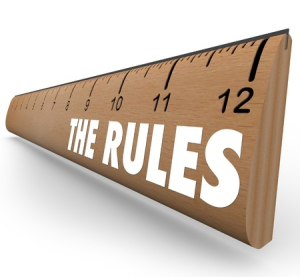By Dr. Ken Broda Bahm:
In the first of Disney’s Pirates of the Caribbean movies, the heroine of the story is demanding to be taken back to shore and invoking something called “The Pirate Code” to make her case. The pirate, Captain Barbossa, responds:
First, your return to shore was not part of our negotiations nor our agreement so I must do nothing. And secondly, you must be a pirate for the pirate’s code to apply and you’re not. And thirdly, the code is more what you’d call “guidelines” than actual rules. Welcome aboard the Black Pearl, Miss Turner.
And that’s the failed legal argument that starts off the adventure. It is also a good illustration of the wiggle room that separates legal rules from legal standards. When it comes to the goal of avoiding or minimizing bias in legal decisions, it is a distinction that makes a difference. Rules (like an automobile speed limit) provide definite direction on a correct outcome. Standards (like a requirement for automobiles to drive “no faster than conditions permit”) are subjective and require decision makers to draw inferences from the facts. Based on a long line of research, implicit bias against a wide variety of social groups is a fact of life, and legal decision makers — jurors, judges, mediators, arbitrators — aren’t immune to that bias. According to a recent study (Girvan, 2016), in civil litigation, instruction on legal rules help to mitigate that implicit bias, while instruction on legal standards does not.”Rules,” Girvan writes, “have a comparative advantage over standards in reducing the impact of bias on legal decisions.” This is a finding that carries some implications for the tools that litigators use in addressing bias in court.
The Research: Rely on Rules, Not Standards
Erik Girvan, Assistant Professor at the University of Oregon School of Law, focused his research on the relative effectiveness of legal rules versus legal standards in reducing implicit bias. In settings outside of court, that pattern tends to bear out with, for example, police officers exhibiting less racial bias in who they pull over when they are using radar rather than their own observations.
He started with 24 mock tort cases involving personal injury, and all based on actual cases that were affirmed on appeal. Half were affirmed based on a legal rule, and half were affirmed based on a legal standard; half also favored plaintiff and half favored defense. Girvan manipulated the fact patterns in order to focus on parties with either traits that are observed to be higher in perceived warmth (a white elderly widow) or traits that are observed to be lower in perceived warmth (a young, black man who may be involved in the drug culture). Then Girvan randomly assigned participants to one of several conditions: no training, training on legal rules, or training on legal standards that required discretion in order to be applied. The instructions were comparable to jury instructions, but with PowerPoint presentations.
Girvan theorized, “If the doctrines provide only general guidance that requires decision makers to draw inferences and make discretionary judgments, then stereotypes will impact the decisions of even those with legal training.” Study One focused on undergraduates, while Study Two focused on law students who had completed a tort law class. For both groups, the instructions focused on legal rules served to reduce bias based on stereotypes, while the instructions based on legal standards did not. Girvan concluded, “The results suggest that, absent affirmative guidance in the form of legal rules, all people, even those with legal training, are potentially ill equipped to decide cases without resorting to stereotypes.”
The Implications:
When You Have a Rule to Refer to:
If the bias would harm you, emphasize the rule. The research actually found use of the rule didn’t just mitigate the effect of stereotypical bias, it reversed it. In other words, the party in the less-favored category was actually a bit more likely to win when the decision makers were instructed using a legal rule.
When You Have Only Standards:
One key fact here is that, if you’re in a jury trial, then your jury is likely hearing standards, not rules. After all, if the case could be resolved by the simple application of a rule, it probably should’ve been decided by a judge in summary judgment. One implication of the research, however, is that when discussing the legal standards when you can (closing, opening, or oral voir dire) making those standards as rule-like as possible, will help to make them a better bulwark against bias. Emphasize what is concrete and definite over what is contingent and subjective. By rhetorically treating the law more as a rule than a guideline, you are deemphasizing the role that bias would otherwise play.
Aristotle wrote that “Law is reason unaffected by desire.” Well, the law may be that. But application of the law is definitely affected by desire, as a long line of research on motivated reasoning amply demonstrates. One reassurance, however, is that the more direct guidance the law gives, the less latitude is given to those desires.
______
Other Posts on Instructions:
- Take a Schematic Approach to Jury Instructions
- Address Your Jury’s Inevitable Difficulty With The Instructions
- Know the Limits of Limiting Instructions (But Don’t Necessarily Discard the Instruction to Disregard)
- Beware of Instructions that Highlight but Don’t Correct
______
Image credit: 123rf.com, used under license
